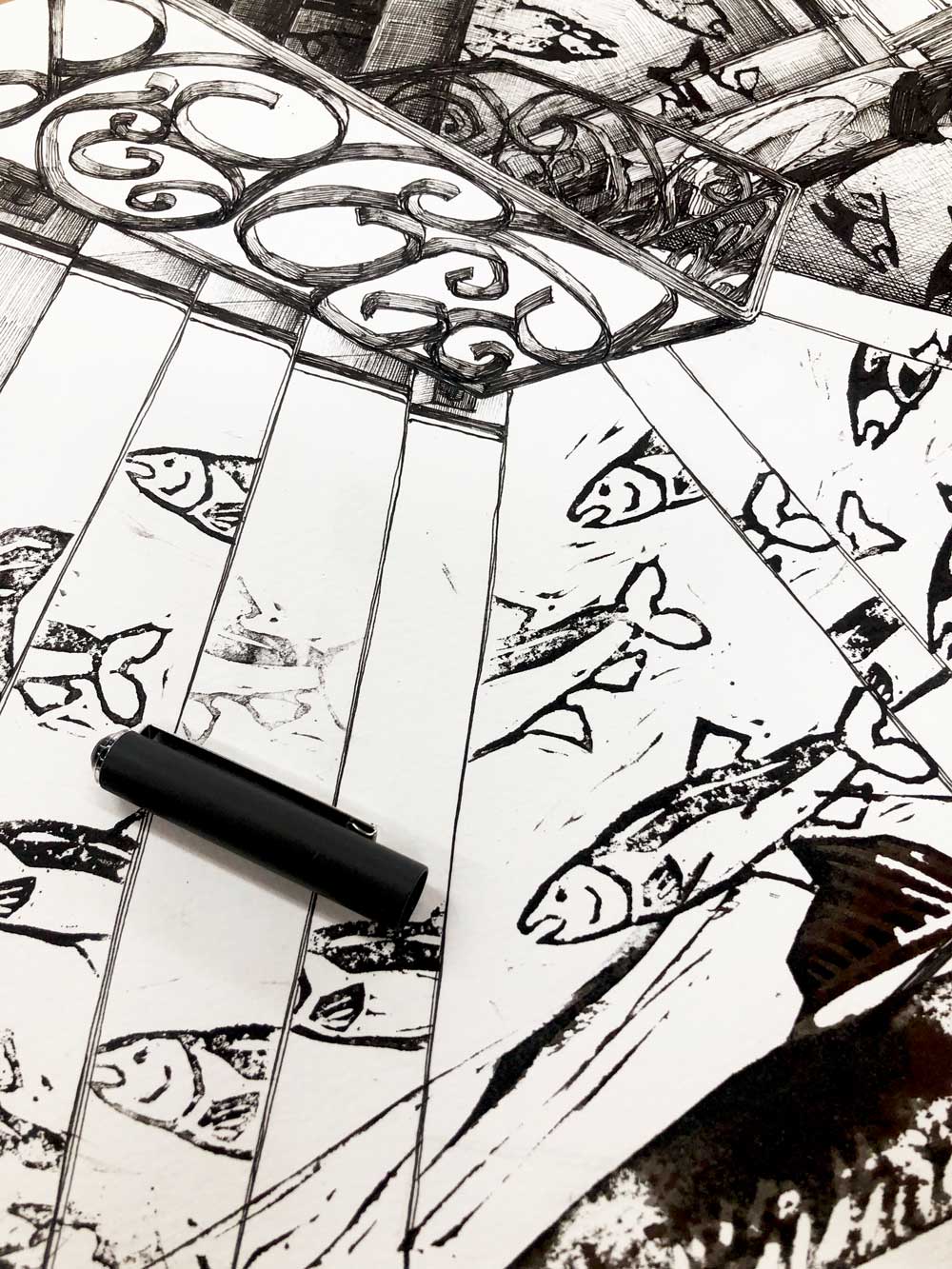
Shannon Yang

AP DRAWING
Korea Kent Foreign School|Seoul, South Korea


Dimension: 12”x1 6”|Material(s): Ink Pen, Brush Pen, Linocut Print, and Pen ink on Paper|Process(es): Crosshatching for value, adding linocut prints for pattern|Curatorial Note: The contrasting of materials, and experimentation of various textures, symbols, patterns create a unique understanding of isolation into solitude. The unique perspective of the monochromatic linocut printmaking design lead the viewer into the composition.
Student statement
Student statement
My overall goal in this investigation was to address the question I posed to myself: "How can an experience of isolation transform into solitude?" I aimed to capture this feeling, explore the effects of comfort in altering isolation into solitude, and reflect on my personal experiences as I navigated through the project.
The title of this piece is "Breakthrough." When I started to develop isolation into solitude, there were many challenging moments that I had to face. Due to my dad’s job, we had moved between countries since I was little. I was okay with this until I became a teenager when friends and commitment to a specific group are essential. Leaving Korea and moving back to the U.S. required that I give up everything I had built, all my friendships, and the feeling of belonging. This caused me to isolate myself from my surroundings. As a new student from a different country, I could not find a group of friends or quickly form connections, and when the pandemic hit, this became even more extreme. After a year of this uncomfortable forced isolation, my family returned to Korea. At that point, my old friends had moved on and forged closer ties with others; unexpectedly, I still felt stressed and like an outcast who did not belong anywhere. However, it was here that I could form an appreciation for this isolation, a breakthrough, as I began to see it as a peaceful solitude.
In this piece, the salmon printed on the stairs symbolizes the concept of a breakthrough. During migration and spawning, salmon confront strong currents and predators going upstream. This process is tumultuous and fraught with danger, but the salmon are driven by an instinct to find a home.
I wanted to portray the salmon with dynamic movement, which led me to experiment with linocut prints. I saw Pablo Picasso's work in an exhibition, where the museum showcased his paintings and his prints. The linocut technique in his pieces, with their bold, dynamic lines carved in various patterns and combinations, impacted me and made me want to try this method.
Using a variety of pens and ink, I wanted to create tonal value. I used printing ink with the image of a simple salmon to show contrast with the background of the drawing, printing with four different-sized salmon linocut prints. The salmon on the right was carved the largest, specifically to show the detailed characteristics of the salmon and to bring out the texture of the linocut print; I printed it using fountain pen ink, giving more depth to the piece by revealing some mahogany tones. I used an ink pen under three different conditions to bring about differing results: brand new for darker tones, used for medium tones, and nearly out of ink for brighter tones. Combined with cross-hatching techniques, this allowed me to portray shadows and lighting easily. The density of a brush pen was used to draw attention to the person walking up the stairs.
Searching for references helped me form my vision as I brainstormed my portfolio. References from artist catalogs, books, Pinterest, and Google guided me in its creation. Furthermore, the freedom in my sketchbook allowed me to find my artistic style with no set rules and record my development continuously. For "Breakthrough," in particular, references and sketches assisted me in the transition of salmon jumping up a waterfall to salmon traveling up the stairs, as if a human struggling against gravity. This symbolizes the upward battle towards my breakthrough. Struggling through social isolation and facing unpleasant encounters, I converted my isolation into solitude; it became a state of comfort, a place just like home, just like what salmon run for.
I genuinely thank my teacher for supporting and guiding me to this place. She was incredibly supportive throughout my portfolio development by providing many examples, inspiration, and advice on emphasizing the meaning I wanted to portray. Throughout the course, my classmates advised me how to connect separate themes and suggested using unfamiliar materials. Because of the extra support, I was able to finish my portfolio.

Progress

Materials: Pencil, Ink Pen, Brush Pen|Process(es): Crosshatching for value, adding linocut prints for pattern.
Reference photo from The Rug Company; carpet design by Barber Osgerby


I wanted to portray the salmon with dynamic movement, which led me to experiment with linocut prints. I saw Pablo Picasso's work in an exhibition, where the museum showcased his paintings and his prints. The linocut technique in his pieces, with their bold, dynamic lines carved in various patterns and combinations, impacted me and made me want to try this method.
Teacher statement
Teacher statement

Sunjung Kim
Why is art powerful? Art is mightier than the pen because art can be understood by people worldwide and transcend barriers through visual language. Therefore, art can deliver a message more effectively to us all.
We can now analyze the meaning behind Shannon Yang’s " Breakthrough" art piece." The piece proposes the message of always persevering. Shannon shows us, through her personal experiences, what it means to break through the challenging moments in our daily lives.
Shannon is a highly talented and diligent student who always creates her work with all effort. Her intellectual curiosity based on visual research was the foundation for creating her artistic style. In addition, the works she has completed for AP Art and Design show higher-order thinking skills and a high level of understanding of art techniques and art mediums. She translated her inquiry into the image, "Breakthrough," with a powerful message reminding us all to persist.
The AP Art and Design program allows students to learn creativity with higher-order thinking skills involving analysis, evaluation, and creation. Therefore, students can learn how to be intellectual artists through the program.
I am incredibly proud of Shannon’s achievements and thank Shannon for trusting my instruction.
Sustained Investigation, Materials: Pencil, Ink Pen, Brush Pen, Linocut Print, Pen Ink, Sticky Note, and Masking Tape on Sketchbook|Process(es): Annotating, idea sketching, attaching linocut with print, and practicing.
Principal statement
Principal statement
Dr. Edward W. Zrudlo
Art trains us to see. It is perception training. At its best, art strips away that film of familiarity that dulls the world we look at and ushers us into a place of awe. Because life is complex and fraught with suffering, art can help us reflect on those aspects and move us in ways that words cannot. Life is also beautiful, thrilling, and full of marvels, and art can guide us to see all that from new perspectives.
Our school motto is Explore, Reflect, Apply, and also my educational philosophy. Art and Music are core subjects equal to English and Math because the arts are concerned with imaginative thinking. Both are required to develop the individual in the most positive way to take on responsibility and grow. Art, like writing, needs technical skills in the student so that she’s able to convey what she sees. Drawing is first seeing what’s there in line and shape and then what could be there imaginatively. As skills are mastered and experience grows, so does the insight into reality and its shading into the transcendent. Shannon Yang’s piece gives us far more than an elaborate fish ladder and raises the question: Are you ready to meet your fish?
Shannon Yang





